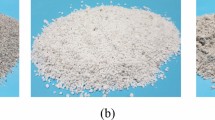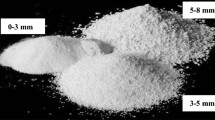Abstract
Expanded perlite is a porous, lightweight material with good thermal insulation properties. Construction materials made of expanded perlite are frequently used in modern buildings for thermal insulation. However, they do not always present sufficient thermal inertia. A solution to increase this inertia is to incorporate a phase change material to make a granular phase change composite. Granular phase change composites are made of granular porous materials and phase change materials by means of vacuum impregnation method. In this study, panels have been made by incorporating phase change composites. Experimental studies have been carried out by measuring temperatures through the panels. The thermal performance of panels subjected to temperature variation is presented in this paper. Experimental results show that incorporation of phase change composites allows the apparent heat capacity to be increased and thus thermal insulation becomes more effective.
Access this chapter
Tax calculation will be finalised at checkout
Purchases are for personal use only
Preview
Unable to display preview. Download preview PDF.
Similar content being viewed by others
Reference
Cabeza LF, Casellon C, Nogues M, Medrano M, Leppers R, Zubillaga O (2007) Use of microencapsulated PCM in concrete walls for energy savings 39: 113–119
Farid MM, Kong WJ (2001) Underfloor heating with latent heat storage Proc Instn Mech Engrs 215: 601–609
Kedl RJ, Stovall TK (1989) Activities in support of the wax-impregnated wallboard concept. U.S. Department of Energy: thermal energy storage researches activity review. New Orleans, Louisiana, USA, 1989
Knudhair AM, Farid MM (2004) A review on energy conservation in building applications with thermal storage by latent heat using phase change materials. Energy Conversion and Management 45: 263–275
Lee T, Hawes DW, Banu D, Feldman D (2000) Control aspects of latent heat storage and recovery in concrete. Solar Energy Mater Solar Cells 62: 217–237
Neeper DA (2000) Thermal dynamics of wallboard with latent heat storage. Solar Energy 68: 393–403
Zhang D, Zhou JM, Wu KR, Li ZJ (2005) Granular phase changing composites for thermal energy storage. Solar Energy 78: 471–480
Author information
Authors and Affiliations
Editor information
Editors and Affiliations
Rights and permissions
Copyright information
© 2007 Springer-Verlag Berlin Heidelberg
About this paper
Cite this paper
Li, Z., Li, X. (2007). Development of thermal insulation materials with granular phase change composite. In: Grosse, C.U. (eds) Advances in Construction Materials 2007. Springer, Berlin, Heidelberg. https://doi.org/10.1007/978-3-540-72448-3_75
Download citation
DOI: https://doi.org/10.1007/978-3-540-72448-3_75
Publisher Name: Springer, Berlin, Heidelberg
Print ISBN: 978-3-540-72447-6
Online ISBN: 978-3-540-72448-3
eBook Packages: EngineeringEngineering (R0)




